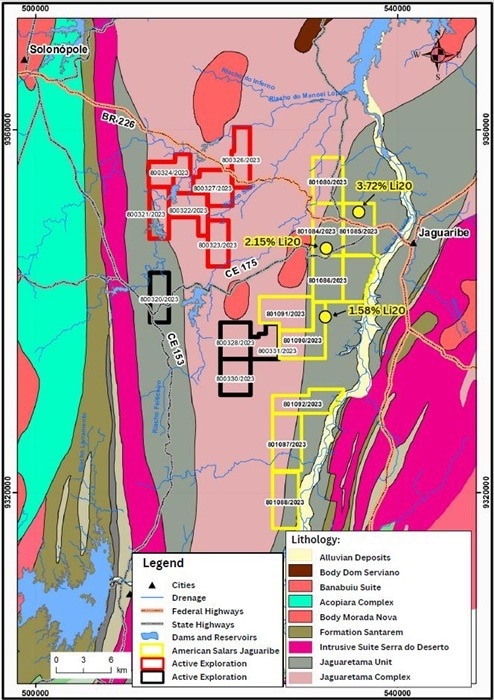Reviewed by Lexie CornerJun 18 2025
American Salars Lithium Inc. declared that it has finished a second sample campaign on its Hardrock LCT (“Lithium-Cesium-Tantalum”) Pegmatite Project, which spans 18,083 hectares (180 square kilometers) and includes critical minerals and rare earth elements (“REEs”).
 Geological Map of the Solonópole/Jaguaribe Region, with USLI’s Jaguaribe claim blocks shown in YELLOW color. Image Credit: American Salars Lithium Inc.
Geological Map of the Solonópole/Jaguaribe Region, with USLI’s Jaguaribe claim blocks shown in YELLOW color. Image Credit: American Salars Lithium Inc.
The Jaguaribe Project is located in the state of Ceará, northern Brazil, in the Jaguaribe/Solonópole region. It contains several large pegmatite dykes that host lithium and REEs.
Initial Phase 1 sampling has reported lithium oxide Li2O concentrations of up to 3.72 %, 2.15 %, and 1.58 %. Other elements identified include 554.5 ppm of cesium, 135 ppm of tantalum, and 177 ppm of niobium. One sample also showed elevated levels of rubidium (>10,000 ppm), tin (675 ppm), and zinc (387 ppm).
We’re pleased to report the completion of our latest sampling program at the Jaguaribe Project. Fourteen pegmatites were identified and sampled, with early indications suggesting the presence of lithium-bearing minerals and rare earth elements. All samples have been sent for advanced multi-element analysis, and we’re excited to see what the lab results reveal as we continue to unlock the potential of this highly prospective region.
R. Nick Horsley, Chief Executive Officer and Director, American Salars Lithium Inc.
Fourteen pegmatites were collected and documented during the recent fieldwork at the Jaguaribe Project study area. These samples have been sent to the laboratory and are currently awaiting analysis.
All 14 samples were submitted to SGS Laboratory for multi-element analysis. The testing includes 56 elements, using ICP-OES and ICP-MS techniques. Elements being analyzed include lithium (Li), niobium (Nb), tantalum (Ta), cerium (Ce), tin (Sn), and a range of REEs.
Any concentrations that exceed detection limits will be further analyzed using the ICP-OES ICP 90A method.
About the Jaguaribe Property
- Located in a historic artisanal mining area for lithium, coltan (tantalum and niobium), and tin
- Initial sampling of the Jaguaribe pegmatites returned spodumene-bearing samples containing up to 3.72 % Li2O, along with REEs.
- Additional LCT pegmatite targets scheduled for testing in Phase 2 sampling
- Situated within Brazil’s established historical pegmatite province
- Approximately four hours by road to the port and international airport in Fortaleza
- Favorable exploration conditions: accessible topography, low vegetation, and compatible land use
- Located in arid, sparsely populated farmland with no rainforest coverage
- Northern Brazil offers access to deep-water ports serving North American and European battery material markets
Pegmatites in the Jaguaribe region typically range from 0.5 to 15 meters in width. They are generally reddish-white to whitish in color and contain gray quartz. Many show consistent directional trends (N10–N15) and are often in contact with schist formations, which are favorable for lithium and related mineralization.
Several pegmatite swarms have been identified, including occurrences along road cuttings and regional access routes. These findings suggest structural continuity and the potential for broader mineralized zones.
Geochemical Characteristics of Pegmatites, Jaguaribe Project, Ceará, Brazil
A total of 58 elements were tested, including REEs. The samples were analyzed using the ICM90A method, which involves fusion with sodium peroxide followed by ICP-OES and ICP-MS detection.
The geochemical profile of the pegmatite samples indicates an LCT-type composition.
This refers to the presence of lithium, cesium, and tantalum.